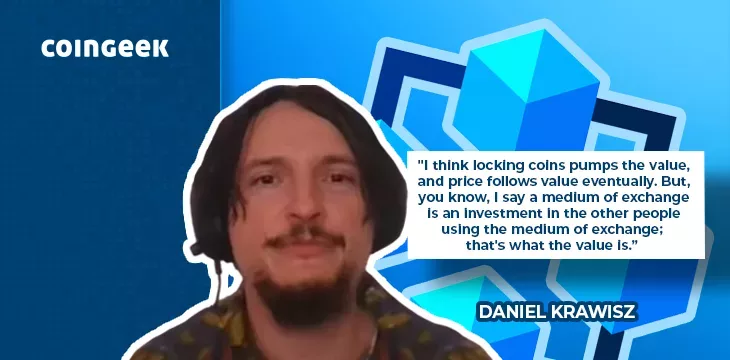|
Getting your Trinity Audio player ready...
|
Locking coins on apps like Hodlocker.com has been a hot topic in BSV blockchain in recent weeks. Bitcoin thought leader and developer Joshua Henslee hosted a CoinGeek Roundtable to discuss it with some of the leading voices in the industry.
Who are the Roundtable panelists?
Henslee is the host. He’s the man behind apps like Windbell and is the face of BSV blockchain’s most popular independent YouTube channel. He has been a vocal supporter of locking coins from the outset.
Joe DePinto is the Co-Founder of Haste, the company behind BSV blockchain’s popular Haste Arcade. He’s a regular at BSV blockchain conferences and pioneered the Instant Leaderboard Payout utilizing BSV micropayments in his arcade.
Greg Ward is the Co-Founder of CertiHash and Rare Generation. He’s also the Chief Development Officer at SmartLedger. Ward is utilizing BSV micropayments and the blockchain in multiple ways, including in the revolutionary Sentinel Node cybersecurity tool.
Daniel Krawisz is an early Bitcoiner, economist, and pioneer of tools like BoostPOW. He’s been at the center of discussions on using proof-of-work to improve the quality of information by making signals costly for a long time.
What is HODlocker.com?
Henslee kicks off the roundtable with a high-level question: what is it we’re talking about here? What is HODLocker?
DePinto answers first; to him, locking coins on apps like this is simply a signal that you’re in this for the right reasons. For example, locking coins for 10 years is a big statement. Attaching locked coins to messages gives that information some weight, as will be discussed later in the Roundtable.
Ward says that while Jack Liu should get full credit for his idea, he also built a simple app that lets people lock their coins using nLocktime. He admits it was a bit premature, and after discussions with David Case, several new features have been implemented, such as QR codes, the ability to easily check block heights, and more. Ward says he has “gone down the rabbit hole of locking script conditions” and sees many different potential use cases.
Why would someone want to lock coins?
For DePinto, this is just a new trend in the community. It’s interesting, and he’s not planning to spend his coins anyway. To outsiders, it sends a signal that the community is committed to doing something together. He also sees value in short-term locking for boosting information such as that there’s a storm nearby – more people doing the same backs that statement up and makes it more likely to be true.
Ward says it’s a good initial signaling tool. He sees many potential use cases, such as prediction markets with locking conditions related to outcomes. There are lots of fun things we could do, he says.
Is this just a Bitcoin savings account?
DePinto says that if someone intends to lock for a long time, it is a form of savings. By using pseudonymous accounts, we can protect our privacy. For him, locking coins attached to information has more utility than cold storage.
Ward says locking coins can function as a savings account, but there can also be many different contractual agreements. For example, we could set up a sort of on-chain trust where coins are released when a child is 21 (calculate the rough block height, and it’s simple enough). He says it’s also possible to fundraise with conditions programmed in that funds will be returned unless specific conditions (e.g., fundraising targets) are met.
Does locking coins defeat the purpose? Aren’t we supposed to use bitcoins rather than hold them?
DePinto repeats a point he hinted at earlier: it has utility because the locked coins can be attached to information. He characterizes this as “giving coins a voice.” Furthermore, holding in and of itself has utility as it builds community. BTC is a prime example of this; while that blockchain doesn’t have anything close to the technical chops of BSV, it has a very strong community and generates lots of interest.
Ward says it’s twofold. Microtransactions allow us to do an unbounded number of transactions. However, coins are property, and people can do whatever they want with them. It’s a valid use case, and nations could even lock coins to back currencies. He agrees that holding builds a sense of community, and the RelayX community is one example of that.
DePinto points out that the idea that holding is the opposite of transacting is false. Hodlocker has generated more transactions than Haste Arcade. Since each lock and unlock requires transactions, it’s generating plenty. Ward says that as we go through halving cycles, we need to generate more transactions for miners, and it’s not our place to judge how they’re generated.
Krawisz enters the discussion at this point, saying that the difference between holding and locking is down to two things: people can see when you lock up, and there are time limits. He likens locking coins up to the upvotes his BoostPOW protocol pioneered, although he still maintains that upvotes backed by proof-of-work are better.
What other features could be added to give HODLocker more utility?
Henslee starts by listing current features: social media style posts, likes, the leaderboard, etc. He wants to hear other suggestions from the panelists.
DePinto says enabling early unlocks at a cost could be useful. For example, perhaps someone who really needs the funds can donate 25% of their coins to the community.
Krawisz disagrees with De Pintos’ idea, saying that the ability to unlock coins changes the economics of the situation—provable cost is the only honest signal. He says pay-to-post could be a useful feature and could help the people working on it generate some income.
Could HODLocker cause the price of BSV to increase?
DePinto thinks that it could draw some interest from people outside the community, increasing demand.
Krawisz says locking coins will increase value, and price follows value eventually. Increasing value won’t necessarily pump the price, but it will make the coins a better buy for whatever they cost.
Ward points out that any use case, in general, shows the value of the chain. However, locking coins is restrictive, and you are removing your freedom to do what you want with your property.
To Wards’ point, Krawisz responds that “it’s impossible to be sexy without hurting yourself.” If you want to lock up coins as a signal, you have to hurt yourself in the process, or the signal has no value. You have to make it so the coins can’t be released – that’s what makes it a costly signal.
How does BSV get more growth in terms of users, price, etc.?
DePinto sees the most value in building a strong community. He says a toxic community in which everyone wants to be right is not attractive to outsiders. We should be more supportive of people trying new things.
Ward says that entrepreneurs in BSV blockchain can insert themselves into every industry. There’s so much misinformation on the surface level, so correcting that by educating people, including legislators, is a positive way to go. He also emphasizes the importance of a positive, supportive community.
How can we leverage locking coins to bootstrap a more efficient economy?
DePinto says the sort of instant feedback it enables increases efficiency. We can instantly test the validity of ideas.
Krawisz draws parallels with previous voting systems, which only allowed those with land to participate. While this was deemed discriminatory, he thinks it would be better if we can exclude people who don’t know what they’re talking about. He thinks that, even if only two people lock up coins to back an idea, this can still be useful; we can consider how many coins they lock up rather than just the number of people engaged in locking.
Is locking coins like proof of stake?
Replying to the criticism that locking coins is like proof-of-stake, Ward says we need more ways to filter signals, including ideas like provable comments.
Henslee says it is dissimilar in other ways—there’s no yield, and proof of stake coins are inflationary. Krawisz says a proof-of-work-based signaling system is better because it has a negative yield—it’s a truly costly signal.
Watch: Using nLockTime payment channels brings accountability

 08-27-2025
08-27-2025 





